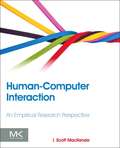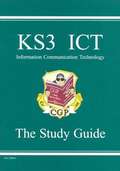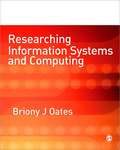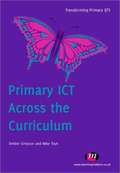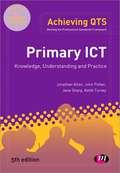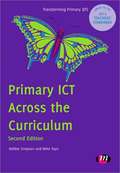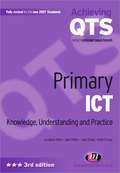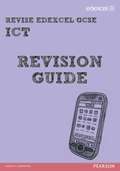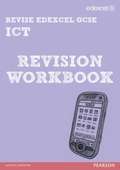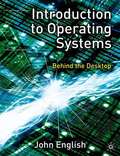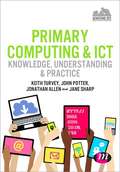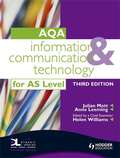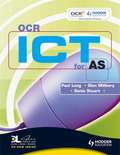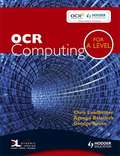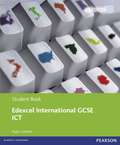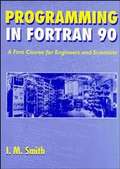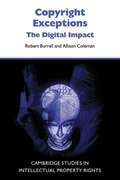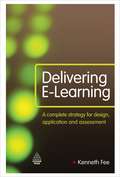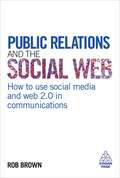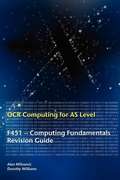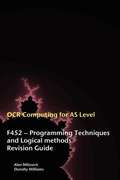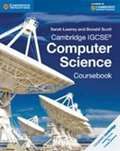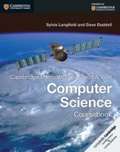- Table View
- List View
Human-Computer Interaction: An Empirical Research Perspective (PDF)
by I. Scott MackenzieHuman-Computer Interaction: An Empirical Research Perspective is the definitive guide to empirical research in HCI. The book begins with foundational topics including historical context, the human factor, interaction elements, and the fundamentals of science and research.
KS3 ICT: The Study Guide (PDF)
by Cgp BooksOur Key Stage 3 Study Book for ICT has got all the core facts, explained clearly and simply, even things like batch processing, feasibility studies, systems analysis and the rest of that ICT gobbledegook. All that tricky technical stuff is now dead easy to get clear with a bit of hard work.
Researching Information Systems And Computing (PDF)
by Briony J. OatesWith everything readers need to know about how to execute their research project, this book is written specifically for information systems (IS) and computing students. It introduces key quantitative and qualitative research methods, makes sense of underlying philosophies, and helps readers navigate and assess existing academic papers.
Primary ICT Across the Curriculum (PDF)
by Debbie SimpsonThe changing landscape of primary teaching requires trainees to consider learning and teaching in new ways. This book supports trainee teachers working towards primary QTS in teaching primary ICT across all areas of the curriculum.
Primary ICT: Knowledge, Understanding And Practice (PDF)
by Jonathan AllenThe Fifth Edition of this popular core text provides essential knowledge and best practice in primary ICT. It helps the reader develop their knowledge, understanding and practice of primary ICT and covers all aspects of how ICT can support learning and teaching in the core areas of the primary curriculum.
Primary ICT Across the Curriculum (PDF)
by Debbie SimpsonThe changing landscape of primary teaching requires trainees to consider learning and teaching in new ways. This book supports trainee teachers working towards primary QTS in teaching primary ICT across all areas of the curriculum.
Primary ICT: Knowledge, Understanding and Practice (PDF)
by Keith Turvey Jane Sharp Jonathan Allen John PotterWritten to familiarise trainees and newly qualified teachers with ICT and its uses in the primary classroom, this text discusses how ICT can support teaching and learning in the core subjects and further teachers' own professional efficiency and development.
Revise Edexcel GCSE ICT: Revision Guide (PDF)
by Nicola Hughes David WallerThis Revision Guide delivers hassle-free exam preparation, covering one topic per page and avoiding lengthy set up time.
Revise Edexcel GCSE ICT: Revision workbook (PDF)
by Harry Smith Nicola Hughes David WallerThis revision workbook delivers hassle-free question practice, covering one topic per page and avoiding lengthy set up time. Build your confidence with guided practice questions, before moving onto unguided questions and practice exam papers. Target grades on the page allow you to progress at the right speed.
Introduction to Operating Systems: Behind the Desktop (PDF)
by John EnglishAnyone who uses a computer is using an operating system, although very few people appreciate what an operating system is or what it does. The most visible part of an operating system is the graphical user interface (GUI) - and yet most of what an operating system does is completely invisible. Introduction to Operating Systems: Behind the Desktop takes a unique approach to the teaching of operating systems, starting with what you will already know - the GUI desktop - before taking you behind, below and beyond the scenes to explore those 'invisible' aspects of the subject. No prerequisite knowledge is assumed other than a general knowledge of programming.
Primary Computing and ICT: Knowledge, Understanding and Practice (PDF)
by Keith Turvey Jonathan Allen John Potter Jane SharpThis popular text for primary trainees in teaching primary ICT has been updated in line with the new computing curriculum. What do you need to know to teach ICT and computing in primary schools? How do you teach it? This book provides practical guidance on how to teach ICT and the computing curriculum in primary schools alongside the necessary subject knowledge.
Information and Communication Technology for AQA AS level (PDF)
by Julian Mott Helen Williams Anne LeemingThis title has been thoroughly edited and updated to meet the demands of the revised AQA specification, supporting flexible delivery and greater opportunities for practical work. It features an updated colour design, new case studies (cross-referenced to the main narrative and practical activities) and new exam-style questions and exemplar answers with an emphasis on supporting candidates in exam preparation and practical work, making this an indispensable core text for all students.
OCR ICT for AS: with Dynamic Learning Student Online (PDF)
by Sonia Stuart Paul Long Glen MilberyThis book has been written by senior examiners and is endorsed by OCR for use with Units G061 and G062 of the OCR GCE AS ICT specification. The content is tailored to the OCR specification and is laid out in an easy-to-understand manner, making use of a variety of methods to convey key learning requirements to students. The book is split into three sections: the theory, which matches the breakdown on the specification the structured tasks, which provide advice on how to approach these examination technique. Students will find this book a valuable guide through both the theoretical and practical elements of the course. By combining print with the Student's Edition of Dynamic Learning online, students have access to some of the additional resources featured in the full network edition CD-ROM as well as a fully interactive edition of the book. The content includes activities and questions, which can be used for homework or classwork, and end-of-chapter tests.
OCR Computing for A level (PDF)
by Chris Leadbetter George Rouse Agneau BelanyekWritten by experts, this book has been written to match Units 1, 2 and 3 of the OCR GCE Computing specification (units F451, F452 and F453) and is endorsed by OCR. The content has been written and and laid out in an easy-to-understand manner, making use of a variety of methods to convey key learning requirements to students. The book is split into four sections: -nbsp;the theory units, matching the breakdown on the specification,nbsp;the examined tasks, which provide advice about how to approach the tasks and prepare for the exam; and - examination technique. Students will find this book invaluable in guiding them through both the theoretical and practical elements of the course.nbsp;
Edexcel International GCSE ICT Student Book (PDF)
by Roger CrawfordEdexcel's own Student Book for the new 2009 Edexcel International GCSE ICT specification Provides complete coverage of the 2009 Edexcel International GCSE ICT specification Attractive, full-colour design and engaging features makes the title accessible for every student. Contains exam practice throughout, with revision questions and practice exam questions. Linked to additional online material for students and teachers, provided by Edexcel, ensuring that you have as much support as possible. Full answers to the Student Book questions are available to teachers and parents by emailing customersolutions@pearson.com (for UK teachers and parents) or icsorders@pearson.com (for all other teachers and parents).
Programming in Fortran 90: A First Course for Engineers and Scientists
by I. M SmithFortran 90 is the most radical revision ever of this popular language, bringing it up to date with current thinking in programming language development. This is the first book aimed directly at problem solving for Engineers and Scientists using the new features of Fortran 90. It can be used as a complete text for students learning Fortran for the first time. It is also a conversion text for those updating from Fortran 77, as differences between Fortran 90 and Fortran 77 are outlined. Array handling and subroutine structures are dealt with as these are a prominent feature of engineers' programs. Emphasis is put on problem exercises for students and on substantial case histories. Model answers to all exercises and cases are given. The programs are available on the Internet via anonymous ftp. Fortran 90 is the most radical revision ever of this popular language, bringing it up to date with current thinking in programming language development. This is the first book aimed directly at problem solving for Engineers and Scientists using the new features of Fortran 90. It can be used as a complete text for students learning Fortran for the first time. It is also a conversion text for those updating from Fortran 77, as differences between Fortran 90 and Fortran 77 are outlined. Array handling and subroutine structures are dealt with as these are a prominent feature of engineers' programs. Emphasis is put on problem exercises for students and on substantial case histories. Model answers to all exercises and cases are given. The programs are available on the Internet via anonymous ftp.
Copyright Exceptions: The Digital Impact (PDF)
by Robert Burrell Allison ColemanThis book was first published in 2005. Copyright 'exceptions' or 'users' rights' have become a highly controversial aspect of copyright law. Most recently, Member States of the European Union have been forced to amend their systems of exceptions so as to comply with the Information Society Directive. Taking the newly amended UK legislation as a case study, this book examines why copyright exceptions are necessary and the forces that have shaped the present legislative regime in the UK. It seeks to further our understanding of the exceptions by combining detailed doctrinal analysis with insights gained from a range of other sources. The principal argument of the book is that the UK's current system of 'permitted acts' is much too restrictive and hence is in urgent need of reform, but that paradoxically the Information Society Directive points the way towards a much more satisfactory approach.
Delivering E-Learning: A Complete Strategy for Design Application and Assessment (1st Edition)
by Kenneth FeeDelivering E-Learning describes a new and better way of understanding e-learning. The author looks at overcoming objections to e-learning and acknowledging poor past practice before presenting a new strategic approach. It places the emphasis firmly on learning, not the technology, de-mystifying the jargon and de-bunking industry myths. The current way most people look at e-learning is flawed, and this means they are missing its full potential. This book provides a clear framework to better understand e-learning. Proposing a strategic approach to implementing e-learning, the author demonstrates how to align e-learning strategy with learning and business strategies. It offers a complete resource for applying e-learning to any organization.
Delivering E-Learning: A Complete Strategy for Design Application and Assessment (1st Edition)
by Kenneth FeeDelivering E-Learning describes a new and better way of understanding e-learning. The author looks at overcoming objections to e-learning and acknowledging poor past practice before presenting a new strategic approach. It places the emphasis firmly on learning, not the technology, de-mystifying the jargon and de-bunking industry myths. The current way most people look at e-learning is flawed, and this means they are missing its full potential. This book provides a clear framework to better understand e-learning. Proposing a strategic approach to implementing e-learning, the author demonstrates how to align e-learning strategy with learning and business strategies. It offers a complete resource for applying e-learning to any organization.
Public Relations and the Social Web: How to Use Social Media and Web 2.0 in Communications (1st Edition)
by Rob BrownThe effect of the internet on public relations is the single biggest subject of current conversation in the public relations industry. As the world of communications changes beyond recognition, those seeking to communicate must revise and revolutionise their approach. Public Relations and the Social Web explores the way in which communications is changing and looks at what this means for communicators working across a range of industries, from entertainment through to politics. The book examines emerging public relations practices in the digital environment and shows readers how digital public relations campaigns can be structured. Including information on new communication channels such as blogs, wikis, RSS, social networking and SEO, Public Relations and the Social Web is essential reading for public relations practitioners, students of public relations, and those who work in related areas such as journalism and web construction and design.
Public Relations and the Social Web: How to Use Social Media and Web 2.0 in Communications (1st Edition)
by Rob BrownThe effect of the internet on public relations is the single biggest subject of current conversation in the public relations industry. As the world of communications changes beyond recognition, those seeking to communicate must revise and revolutionise their approach. Public Relations and the Social Web explores the way in which communications is changing and looks at what this means for communicators working across a range of industries, from entertainment through to politics. The book examines emerging public relations practices in the digital environment and shows readers how digital public relations campaigns can be structured. Including information on new communication channels such as blogs, wikis, RSS, social networking and SEO, Public Relations and the Social Web is essential reading for public relations practitioners, students of public relations, and those who work in related areas such as journalism and web construction and design.
OCR Computing for A-Level - Computing Fundamentals Revision Guide (PDF)
by Dorothy Williams Alan MilosevicThis revision guide provides extensive notes, exam questions and model answers covering the current syllabus of F451 - Computing Fundamentals.
OCR Computing for A-Level - Programming Techniques and Logical Methods Revision Guide (PDF)
by Dorothy Williams Alan MilosevicThis revision guide provides extensive notes, exam questions and model answers covering the current syllabus of F452 - Programming Techniques and Logical Methods.
Cambridge IGCSE Computer Science: Coursebook (1st edition) (PDF)
by Donald Scott Sarah LawreyThis new resource is written to follow the updated IGSCE Computer Science syllabus 0478 with examination in June and November 2016. Cambridge IGCSE Computer Science provides a comprehensive coursebook that covers recent developments in computer science. It offers support on theoretical and practical aspects of the Cambridge International Examinations Computer Science (0478) syllabus, written by experienced computer science trainers. The coursebook contains detailed explanations of the concepts required, with examples and tasks to help consolidate your knowledge, and introduces the foundations of programming that students need to learn. A Programming book is also available for this course to support students develop their practical programming skills. Task-based learning builds up skills, guiding you through projects and providing examples of real coding solutions.
Cambridge International AS and A Level Computer Science Coursebook (PDF)
by Dave Duddell Sylvia LangfieldThis coursebook delivers an accessible guide to the theoretical and practical skills that are required by the course, with a clear progression of tasks that consolidate and develop knowledge. It offers students detailed descriptions of the concepts, reinforced with examples that outline complex subject matter in a clear way. Alongside fundamental definitions, higher level programming skills are developed through the explanation of processes and consolidated by practical exam-type questions for students to attempt. Cambridge International AS and A Level Computer Science provides a set of resources to students and teachers following the Cambridge AS and A Level syllabus (9608). It delivers clearly written information to help develop the theoretical and practical skills required by the course, with a clear progression of tasks that consolidate and develop knowledge. The coursebook offers students detailed descriptions of the concepts, reinforced with examples that outline complex subject matter in a clear way. A teacher resource and revision guide are part of this set of resources.
